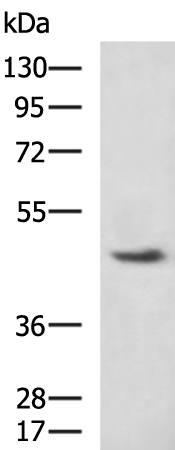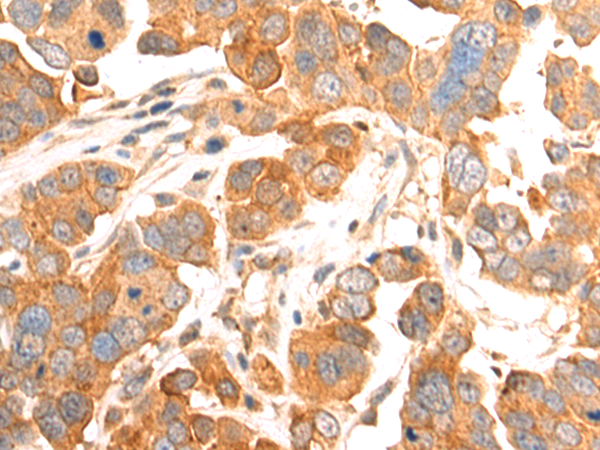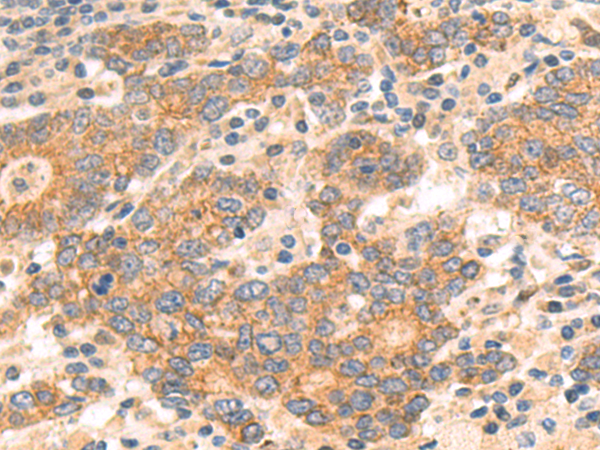


| WB | 咨询技术 | Human,Mouse,Rat |
| IF | 咨询技术 | Human,Mouse,Rat |
| IHC | 1/50-1/200 | Human,Mouse,Rat |
| ICC | 技术咨询 | Human,Mouse,Rat |
| FCM | 咨询技术 | Human,Mouse,Rat |
| Elisa | 1/5000-1/10000 | Human,Mouse,Rat |
| Aliases | MST130; DFNB102; DFNB103; MSTP130 |
| WB Predicted band size | 47 kDa |
| Host/Isotype | Rabbit IgG |
| Antibody Type | Primary antibody |
| Storage | Store at 4°C short term. Aliquot and store at -20°C long term. Avoid freeze/thaw cycles. |
| Species Reactivity | Human, Mouse, Rat |
| Immunogen | Fusion protein of human CLIC5 |
| Formulation | Purified antibody in PBS with 0.05% sodium azide and 50% glycerol. |
+ +
以下是关于CLIC5抗体的3篇参考文献及其简要摘要:
---
1. **文献名称**: *"CLIC5 stabilizes membrane-cytoskeleton interactions in sensory hair cells via domain-specific interactions"*
**作者**: Gagnon LH 等
**摘要**: 该研究利用CLIC5抗体进行免疫定位,发现CLIC5通过与膜和细胞骨架蛋白相互作用,维持内耳毛细胞的结构完整性。基因敲除小鼠表现出听力障碍,提示CLIC5在听觉功能中的关键作用。
---
2. **文献名称**: *"CLIC5A is a novel biomarker for gastric cancer progression and prognosis"*
**作者**: Wang Y 等
**摘要**: 通过CLIC5抗体进行免疫组化分析,发现CLIC5A在胃癌组织中高表达,并与肿瘤转移和患者生存率相关。研究表明其可能通过调节细胞迁移通路促进癌症进展。
---
3. **文献名称**: *"CLIC5 deficiency leads to disrupted ciliogenesis and accelerated diabetic kidney injury"*
**作者**: Zhang X 等
**摘要**: 利用CLIC5抗体发现其在肾小球足细胞纤毛中高表达。CLIC5缺失导致纤毛结构异常,加剧糖尿病小鼠的蛋白尿和肾损伤,提示其在肾脏疾病中的保护作用。
---
4. **文献名称**: *"CLIC5 modulates endothelial ROS signaling and angiogenesis"*
**作者**: Singh H 等
**摘要**: 研究通过CLIC5抗体和基因沉默技术,证明CLIC5通过调节活性氧(ROS)平衡影响血管内皮细胞的迁移和血管生成,为心血管疾病治疗提供新靶点。
---
以上文献均通过CLIC5抗体在特定实验(如免疫荧光、Western blot或组织染色)中验证其功能,涵盖听觉、癌症、肾脏病及血管生成等领域。如需具体发表年份或期刊,可进一步补充检索。
CLIC5 (Chloride Intracellular Channel 5) is a member of the CLIC family of proteins, which exhibit dual soluble and membrane-associated forms implicated in ion channel activity and cellular homeostasis. CLIC5 is expressed in various tissues, including the kidney, inner ear, heart, and skeletal muscle, with roles in cytoskeletal organization, membrane trafficking, and cell signaling. It interacts with cytoskeletal components like ezrin and actin, influencing structural integrity and dynamic processes in specialized cells, such as stereocilia in auditory hair cells or podocytes in renal glomeruli.
Dysregulation of CLIC5 has been linked to pathologies. For instance, mutations are associated with hearing loss and vestibular dysfunction in mice and humans, while altered expression is observed in cancers (e.g., breast, colorectal) and kidney diseases. In cancer, CLIC5 may promote tumor progression by modulating cell migration or chemoresistance.
CLIC5 antibodies are critical tools for studying its localization, expression, and function. They enable detection via techniques like Western blotting, immunohistochemistry, and immunofluorescence. Specific antibodies targeting different isoforms (CLIC5A/B) or post-translational modifications help dissect its regulatory mechanisms. Research using CLIC5 antibodies has advanced understanding of its role in cellular physiology and disease, aiding therapeutic target exploration. Validation of antibody specificity remains essential due to homology among CLIC family members.
×